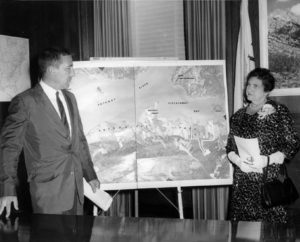The historical events listed below, which come from a variety of resources (referenced at the end of the timeline), have shaped the cultural heritage of the Moyaone Reserve and Piscataway Park. This page is a work in progress, and will be revised, corrected, and added to as we learn more about our history. If you know of additional sources of information that may enrich this timeline, please contact Rose Kim.
Up to 1608: Algonquin tribes — to include the Piscataway, Conoy, and Mattaponi — rule lands along the Potomac River from present-day Washington, DC, to the Chesapeake Bay, including in present-day Accokeek, called “Moyaone.” (Pronounced Moy-own).
1608: Captain John Smith arrives in Jamestown, Virginia, marking the beginnings of European colonization along the Potomac River and beyond.
1630s-1790s: European settlements drive away native peoples from their lands and enslaved Africans are brought in to establish tobacco farm empires along the Potomac River in Prince Georges and Charles counties.
1864-1865: The Civil War ends and Maryland adopts a new constitution banning slavery.
1930: The Fergusons initiate archeological digs on Hard Bargain Farm and discover artifacts from the indigenous peoples of the Moyaone. Their discoveries, along with later discoveries by the Smithsonian Institute and the University of Michigan, provide evidence of Native American occupation dating back thousands of years.

1945-1949: The Fergusons purchase hundreds of acres of farmland surrounding Hard Bargain Farm and begin selling minimum five-acre lots to friends who share their land conservation values. A community of scientists, authors, teachers, artists, activists, and architects begins to form, and the community is referred to as the Moyaone Reserve. Architects Charles F. Wagner and Charles Goodman are among the architects who build the first modernist houses in the Moyaone Reserve.
1952: Alice dies and Henry donates Hard Bargain Farm and other properties to the community. In 1953, the community establishes the Moyaone Company to accept the gift of land. The Moyaone Company begins publicly advertising five-acre minimum lots for sale, upselling the rural retreat lifestyle so close to DC.
1954: The Alice Ferguson Foundation is established with the mission of stewarding Hard Bargain Farm and promoting environmental conversation.
1955: A commercial utility development project threatens a 485-acre farm on the Potomac River directly across from Mount Vernon and beside the Moyaone Reserve. Residents and community activists on both sides of the river galvanize support from public officials. Congresswoman Francis Bolton (R-OH), a member of the Mount Vernon Ladies’ Association, responds by purchasing the farm to protect the site from development and pushes legislation through Congress to establish a national park.

1957: The Accokeek Foundation is formed by Congresswoman Bolton to steward the 485-acre farm.
1959: The National Colonial Farm is established by Congresswoman Bolton, the Accokeek Foundation, and the National Park Service.
1961: Congress passes Public Law 87-362 authorizing the Secretary of the Interior to acquire and maintain lands to preserve the view from Mount Vernon. The Alice Ferguson Foundation and Moyaone Reserve residents donate land towards the establishment of the park.
1966: The indigenous Moyaone site, today referred to as Accokeek Creek, is designated as a National Historic Landmark.

1968: Piscataway Park is officially dedicated to public as a national park. Congresswoman Bolton, Piscataway Chief Turkey Tayac, and other stakeholders attend the ceremony.
1979: Piscataway Chief Tayac is buried in the original Moyaone site in Accokeek Creek Park.
1979: Piscataway Park, some 4,216.53 acres, is nominated and accepted into the National Register of Historic Places. In the short form of that National Register nomination, pages 6 and 7 show the boundaries of Piscataway National Park, which includes the lands that make up the Moyaone Reserve within the Park’s boundary. Like countless National Parks throughout the United States, the Moyoane Reserve properties are private lands and are considered in-holders to the park.
2012: The Governor of Maryland formally recognizes the Piscataway Indian Nation and Conoy tribe in the State of Maryland.
2016: Crewmembers of the Hōkūleʻa visit the Piscataway Indian Nation on the shores of the Potomac River during a stopover on their Mālama Honua mission of their worldwide voyage.
2018: The National Trust for Historic Preservation names Piscataway Park one of the 11 Most-Endangered Sites after Dominion Energy attempts to build one of the largest gas compressor stations on the East Coast within the Mount Vernon view shed. Dominion Energy withdraws its plans in June 2018 after local and national outrage from organizations and members of the public.
2019: The Moyaone Reserve submits an application and is approval for inclusion in the National Register of Historic Places.
Sources: The National Park Service / Alice Ferguson Foundation / Accokeek Foundation / George Washington’s Mount Vernon / The Washington Post / Baltimore Sun / WAMU 88.5